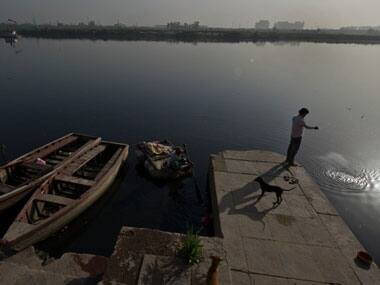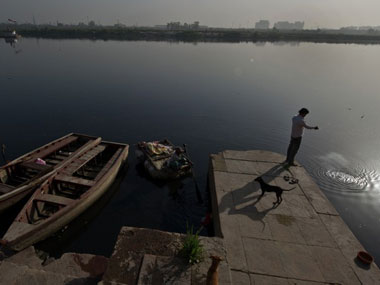New Delhi: Prime Minister Narendra Modi’s proposal to replicate the Sabarmati Riverfront Project on the Yamuna river in Delhi has attracted strong reactions from environmentalists who feel such a move will “kill the river”. The proposal is a result of last month’s meeting between Delhi’s Lieutenant Governor Najeeb Jung and Modi. The week following that meeting, the Delhi government sent three teams to Gujarat to “study successful projects in different fields”. One of them was a 13-member team comprising bureaucrats and scientists to study the Sabarmati Riverfront Project and to “suggest how the concept can be used for effective implementation of Yamuna Riverfront Development Scheme in Delhi”. The riverfront development scheme includes setting up of recreational facilities along the Yamuna. [caption id=“attachment_1578749” align=“alignleft” width=“380”]  Yamuna river in New Delhi. AFP[/caption] Incidentally, a little over a month ago a three-member expert committee set up by the Ministry of Environment and Forests in its report to the National Green Tribunal had recommended that the Yamuna Riverfront Development Scheme be scrapped. Any further construction on Yamuna’s floodplains and on the riverbed, the report had warned, would only increase the risk of flooding and add to the pollution. The Centre, however, appears to be keen on implementing the Yamuna Riverfront Development Scheme and, going by the L-G’s enthusiasm for all things in Gujarat, and his keenness on following in the footsteps of the Ahmedabad Municipal Corporation. But the Sabarmati Riverfront Project, experts warn, is not designed to revive or rejuvenate the river. “It is absolutely wrong to say that the Sabarmati River has been restored. They have diverted part of the Narmada canal water into the previous channel of Sabarmati. It is just a 10.5 km long artificially created canal that exists in Ahmedabad. Upstream and downstream of that canal there is no river. How can a 350 km long river be said to be restored when water from some other source has been put into a 10.5 km stretch of that river? We don’t think there is anything called the Sabarmati restoration model and to even think that this model can be replicated in Yamuna in Delhi or the Ganga is a fallacy… Such projects are not meant to restore the river. They will further kill the river,” says Manoj Misra, convener of Yamuna Jiye Abhiyaan. Responding to arguments that the Sabarmati project has succeeded in turning a dry stretch of land into an attractive urban space, Misra said, “All that is beautiful is not necessarily right. Does the government want a beautiful canal in the city of Delhi or does it want to restore a river? The government has to decide what its objective is. But don’t say you want to restore the river and at the same want to have a canal-front Delhi. Both are not possible. They are not compatible,” says Misra. The proposal has been also been strongly opposed by senior scientist CR Babu who was part of the team that was sent by the Delhi government to study the project. Babu, professor emeritus at Delhi University’s Centre for Environmental Management of Degraded Ecosystems, has submitted a detailed report to the Delhi government on why the Sabarmati Riverfront project should not be used as a model for Yamuna. “What I observed is that there is no Sabaramati river in the Sabarmati river front development project. The river has become extinct or rather has been eclipsed. What you see is a stagnant water body bounded on both sides by a RCC (reinforced cement concrete) walls. There is no movement of water so you can’t call it a river,” says Babu. Puncturing the claim that the Sabarmati river is clean and free of pollutants, the scientist says, “The water body is polluted. It is full of algal blooms, including toxic microcystis blooms which produce toxins that cause irritation in skin. In other words, the water is not suitable for bathing… And downstream of Vasna barrage it’s converted into toxic effluents. This toxic waste comes from the industrial estate in Ahmedabad. Highly red-coloured water is discharged into the water with large number of chemicals with high levels of COD (chemical oxygen demand). There is no living organism in that.” By concretising large swathes of the riverbed with RCC walkways and public transport roads and allocating space for real estate projects and a manicured garden, the Sabarmati river, says Babu, has been “used for urban renewal and urban infrastructure”. Questioning the basis for considering the Sabarmati project as a model for the Yamuna, Babu says,“Downstream of Vasna barrage it is converted into toxic effluents and upstream of Vasna barrage, it is a stagnant water body that is polluted. And further upstream, there is nothing but a dried up river-bed. And where does the water for the water body come from? The Narmada canal. So where is the Sabarmati river? How can you use this model for rejuvenation?” So what should be the government’s approach be to revive and clean the Yamuna? Despite over Rs 1,000 crore having been spent over the last two decades under the Yamuna Action Plan I and II, Yamuna continues to be one of the most polluted rivers in India. The focus on pollution alone and sloppy implementation of the clean-up drives, say experts, are partly to blame for the government’s failure to rescue the Yamuna despite the money and time spent on it. “There are three kinds of problem with the Yamuna. One is that the river for about 200 km upstream of Delhi has been diverted. A river that does not flow is no river. The first thing that has to be done is to bring back ecological flow” back into the river. That won’t happen unless an MoU that was signed between different states way back in 1994 is revised. Second, the flood plain of the river has to be protected against anymore conversion because Yamuna is a flood-prone river and the water security of Delhi depends on floods actually happening in the river Yamuna. That is only way it recharges the ground water. And about 30 percent of city still depends on ground water extraction for meeting water needs. So let the river flow freely and let the river flood freely and the river will come back,” says Misra. The third problem, he adds, is the flow of industrial waste and sewage into the river. “A river has a natural rejuvenational power but that power become helpless in front of toxic matter that is not organic. And so all the industrial waste and the sewage has to be kept away from the river.”
The proposal has been also been strongly opposed by senior scientist CR Babu who was part of the team that was sent by the Delhi government to study the project.
Advertisement
End of Article


)

)
)
)
)
)
)
)
)



